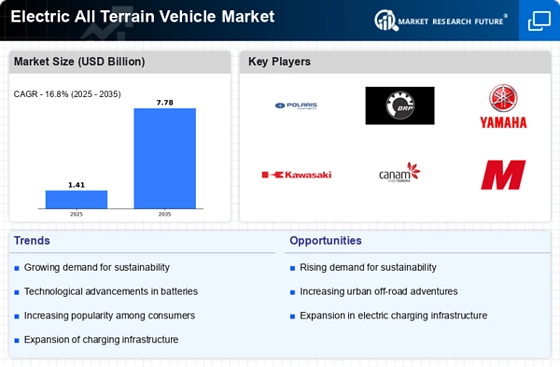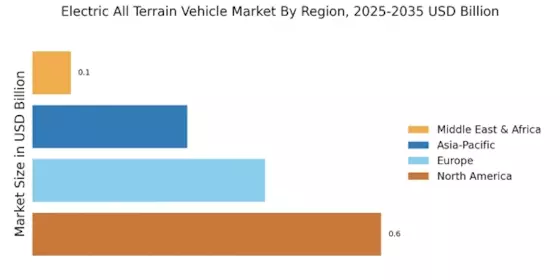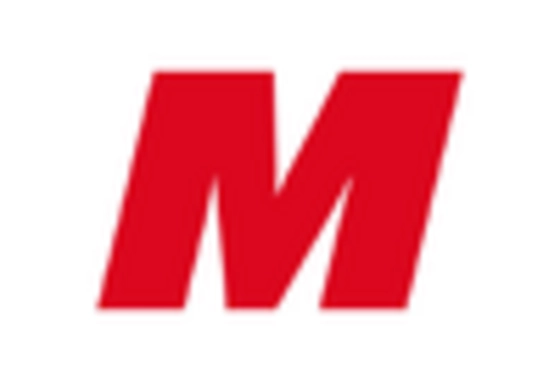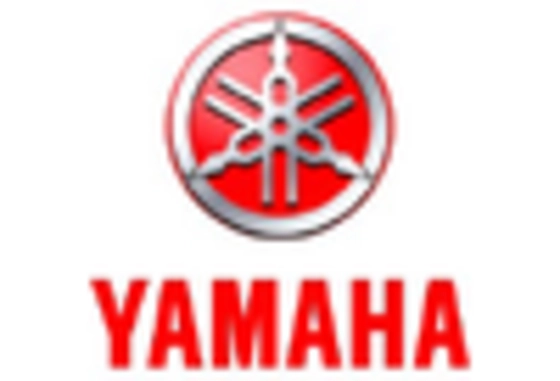Sustainability Initiatives
The Electric All Terrain Vehicle Market is experiencing a notable shift towards sustainability initiatives. As environmental concerns gain traction, manufacturers are increasingly focusing on producing electric all-terrain vehicles that minimize carbon footprints. This trend is driven by regulatory pressures and consumer demand for eco-friendly alternatives. In 2025, the market is projected to grow at a compound annual growth rate of 12%, reflecting a rising preference for sustainable transportation solutions. The integration of renewable energy sources in vehicle production further enhances the appeal of electric all-terrain vehicles, positioning them as a viable option for environmentally conscious consumers. As a result, the industry is likely to witness a surge in investments aimed at developing innovative, sustainable technologies that align with global sustainability goals.
Technological Advancements
Technological advancements play a pivotal role in shaping the Electric All Terrain Vehicle Market. Innovations in battery technology, such as solid-state batteries, are enhancing the performance and range of electric all-terrain vehicles. These advancements not only improve the user experience but also address concerns regarding charging infrastructure. In 2025, the market is expected to see a significant increase in the adoption of smart technologies, including connectivity features and autonomous driving capabilities. This integration of cutting-edge technology is likely to attract a broader consumer base, including outdoor enthusiasts and recreational users. As manufacturers continue to invest in research and development, the Electric All Terrain Vehicle Market is poised for substantial growth, driven by the demand for high-performance, technologically advanced vehicles.
Increased Consumer Awareness
Increased consumer awareness regarding environmental issues is a key driver for the Electric All Terrain Vehicle Market. As individuals become more informed about the impact of their choices on the environment, there is a growing preference for electric vehicles over traditional options. This shift in consumer behavior is evident in the rising demand for electric all-terrain vehicles, which are perceived as a more sustainable choice. In 2025, the market is anticipated to expand as consumers actively seek out eco-friendly alternatives for their recreational needs. Manufacturers are responding to this trend by emphasizing the environmental benefits of electric all-terrain vehicles in their marketing strategies. Consequently, the industry is likely to experience a surge in sales as awareness continues to grow, further solidifying the position of electric vehicles in the all-terrain segment.
Rising Outdoor Recreation Trends
The Electric All Terrain Vehicle Market is benefiting from the rising trends in outdoor recreation. As more individuals seek adventure and exploration, the demand for all-terrain vehicles is on the rise. In 2025, the market is projected to expand as consumers increasingly opt for electric models that offer a quieter and more environmentally friendly experience. This shift is particularly evident among younger demographics who prioritize sustainability and outdoor activities. The growing popularity of eco-tourism and outdoor sports is likely to further fuel the demand for electric all-terrain vehicles, as they provide an ideal solution for accessing remote locations without disturbing the natural environment. Consequently, the industry is expected to adapt to these changing consumer preferences, leading to innovative product offerings that cater to the outdoor recreation market.
Government Incentives and Regulations
Government incentives and regulations are significantly influencing the Electric All Terrain Vehicle Market. Many governments are implementing policies aimed at promoting electric vehicle adoption, including tax credits, rebates, and grants for manufacturers. These initiatives are designed to encourage consumers to transition from traditional fuel-powered vehicles to electric alternatives. In 2025, the market is likely to benefit from increased regulatory support, which may include stricter emissions standards and incentives for sustainable practices. Such measures not only enhance the attractiveness of electric all-terrain vehicles but also stimulate competition among manufacturers to innovate and improve their offerings. As a result, the industry is expected to witness accelerated growth, driven by favorable government policies that align with environmental objectives.


















Leave a Comment